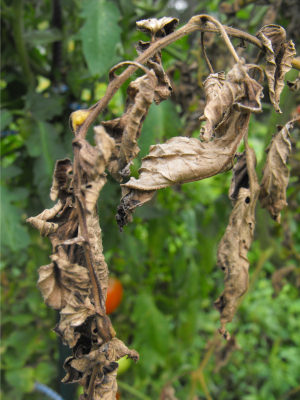
Tomato fungal diseases

 Although
I thoroughly enjoyed last week's
deluge, the tomatoes
didn't. I had been keeping a pretty good handle on the early
blight, but several
days of damp spread other fungi and I can tell our tomatoes
are now on the decline.
Although
I thoroughly enjoyed last week's
deluge, the tomatoes
didn't. I had been keeping a pretty good handle on the early
blight, but several
days of damp spread other fungi and I can tell our tomatoes
are now on the decline.
The pictures at the top
of the post show our new septoria leaf spot
infection. At a quick glance, these spots look a lot like early
blight, but notice that the septoria spots are smaller, more numerous,
have a
pale center, and aren't ringed by a halo of yellow. (There is
some yellowing on the leaf, but it doesn't encircle the spots.)
Meanwhile, late blight
has struck as well. About a third of the leaves on a
couple of plants have curled up and turned brown, and I'm beginning to
see rotten tomatoes on the vine.
Perhaps if the septoria
and late blight had hit the tomato patch during dry weather, I would
have been able to use extreme pruning to keep them at bay. But
somewhere in the course of last week's dozen inches of rain, the
septoria managed to colonize every tomato plant in our garden,
infecting even the upper leaves. My only option is to harvest as
fast as possible and accept that our tomatoes won't be much longer in
this world.
Despite all of this
death and destruction, I can't complain. We're close to our goal
of frozen tomato products --- enough to make pizza, spaghetti, and
vegetable soup twice a month apiece for an entire year. I was
hoping to experiment with ketchup and add some dried tomatoes to the
larder, but at this point I'm happy to take what I can get.
Want more in-depth information? Browse through our books.
Or explore more posts by date or by subject.
About us: Anna Hess and Mark Hamilton spent over a decade living self-sufficiently in the mountains of Virginia before moving north to start over from scratch in the foothills of Ohio. They've experimented with permaculture, no-till gardening, trailersteading, home-based microbusinesses and much more, writing about their adventures in both blogs and books.
Want to be notified when new comments are posted on this page? Click on the RSS button after you add a comment to subscribe to the comment feed, or simply check the box beside "email replies to me" while writing your comment.
